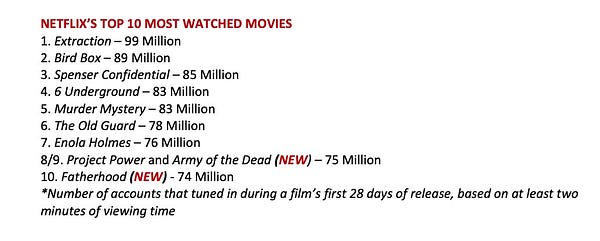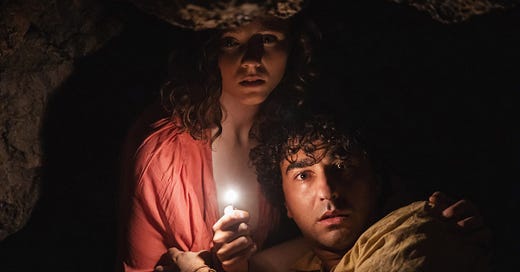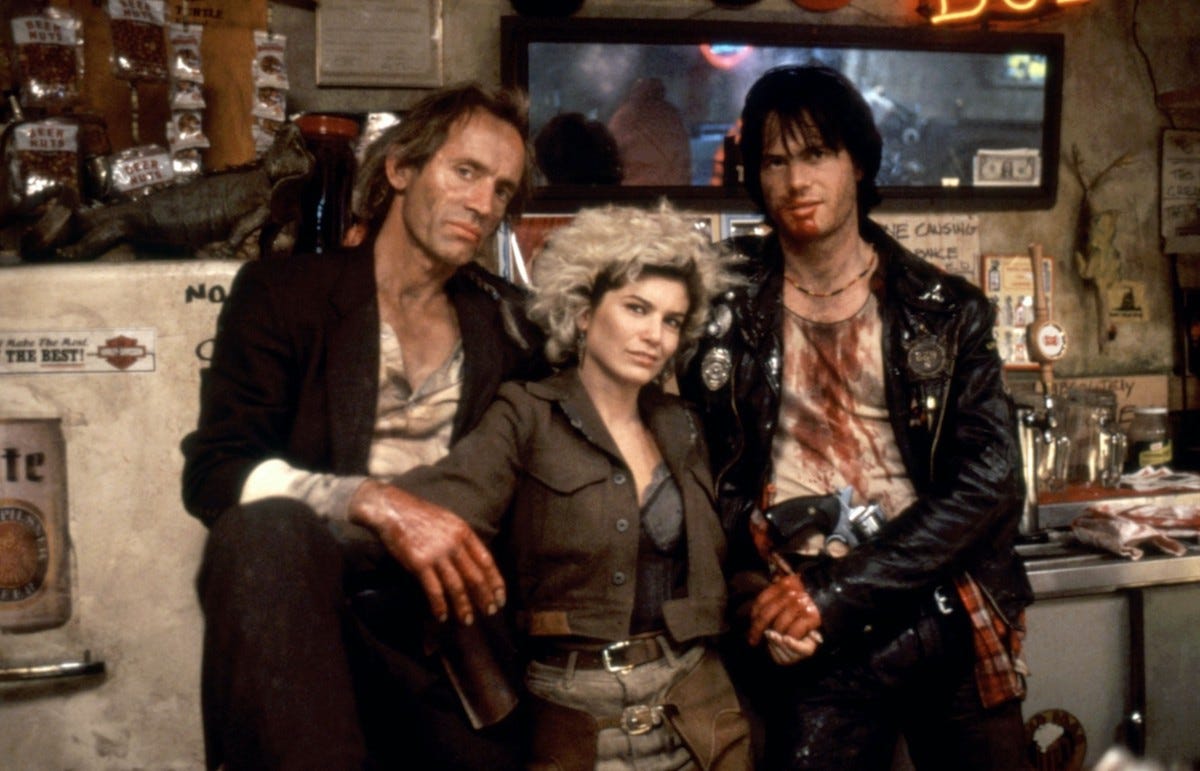Old Review
M. Night Shyamalan’s new movie is over-the-top and faintly ridiculous—the elevator pitch is something like, “What if a family went to a beach, started aging insanely fast, and couldn’t leave it? That’d be scary, right?”—and has more endings than the extended edition of Lord of the Rings: Return of the King. And yet, despite its flaws, I still kind of enjoyed it!
Guy (Gael García Bernal) and Prisca (Vicky Krieps) take their two children Maddox (aged 11) and Trent (aged 6) to an island getaway for one last family holiday. Guy and Prisca are getting divorced; Maddox and the precocious Trent, who is wont to ask strangers their names and occupations, are handling it about as well as you could expect a couple of kids watching their parents’ marriage fall apart to handle it.
The quartet is offered a trip to a secluded beach by the resort manager. They’re joined by two more groups: one is a family with an older woman and a 6-year-old girl; the other is a childless middle-aged couple. Already on the beach when the group arrives is the mysteriously quiet rapper, Mid-Sized Sedan (Aaron Pierre). (And yes, the reveal of Mid-Sized Sedan’s name as “Mid-Sized Sedan” did, in fact, inspire the biggest laughs of the movie.)
So, there’s your setup: a group of strangers on the beach. Things take a turn when Trent stumbles upon a body in the water. What killed Mid-Sized Sedan’s female companion? Or, possibly, who killed Mid-Sized Sedan’s female companion? And things take a further turn when Maddox, Trent, and another child on the beach start aging at a rapid rate, growing leaps and bounds in a matter of hours.
Old pushes up against the boundaries of its PG-13 rating, to the point that I was somewhat surprised when I got home and found it was, in fact, a PG-13 film. It quite frequently dips its toes into body horror, that subgenre of terror that revolves around the fear of losing bodily integrity. At one point, a character is forced to undergo emergency surgery to remove a tumor that is growing at a fantastic rate, from golf ball to softball to cantaloupe in a few minutes. Because of the speed of cellular regeneration on this beach, incisions heal almost instantly, forcing those on the beach with her to literally reach down and hold the gash in her stomach open, prying apart the flesh to get to the cancerous mass within.
The sort of dread that body horror inspires is, in my humble opinion, the scariest that scary movies can gin up, way scarier than randomly increasing the soundtrack volume while having a guy jump into frame. And that’s because it calls to mind an inevitable truth: Eventually, all of our bodies are going to fail us. This is demonstrated most vividly via the disintegration of Chrystal (Abbey Lee), who appears to be an Instagram influencer of some sort and whose reliance on her beauty to find meaning is ill-suited for a situation in which rapid aging is the norm. But she’s not alone. All of our systems are going to break down. Our hearing will falter; our sight will flee; our cells will spin out of control and consume us from within; our organs will fail. “Old” is the only disease you don’t recover from, and Old understands that.
Shyamalan’s at his best here when leaning into the truly goofy ideas at the heart of the premise. What if a 6-year-old aged into a 50-year-old’s body? What if a surgeon with a degenerative mental condition degenerated in the midst of surgery? What if you stuck a rapper named Mid-Sized Sedan on a beach with a bunch of people who thought he might be a murderer and were not named after vehicle body types?
Unfortunately, and I feel slightly weird saying this, Old isn’t quite ridiculous enough. It would’ve benefitted from leaning into the non sequiturs a bit harder (one of the characters is desperately in need of IMDB, for instance, and every time he asks his movie-related question it made me laugh uncomfortably) or letting the what-a-twist ending stand on its own without adding three separate codas that undermine the cinematic trolley problem Shyamalan’s film proposes. I won’t spoil the ending(s) here except to say that Shyamalan nudges up to something provocative and interesting but backs away from it at the last moment.
That said, the director of Unbreakable and Split remains the consummate craftsman, completely in control of the image onscreen. Say what you will about his reliance on twists: The guy knows how to frame a shot and keep the camera in motion to deliver and withhold information in a way that generates earned suspense rather than cheap jump scares.
No twist ending here: Become a Bulwark+ member now to unlock the comments section on this post and ensure that this newsletter remains sustainable in a changing media environment.
Netflix’s Data Dumps
A few months back I asked the Entertainment Strategy Guy (to whose newsletter you should subscribe!) how much confidence we should have in Netflix’s datecdotes, the little snippets of information they release about how their shows and movies have performed. I was curious because I realized Netflix was saying things like “72 million households are betting on dead” to announce that 72 million households had watched Zack Snyder’s zombie opus, Army of the Dead.
Make that 72 million households—over the first four weeks of release.
Now, that little proviso is pretty important, because, obviously, they don’t have four weeks’ worth of data when they release the numbers in the days following a film’s release. They have … a few days of numbers! The 72 million, then, is a projection.
And projections aren’t always accurate.
Hence my question to the ESG about Netflix’s data. How reliable are these numbers? The answer seems to be this: “If Netflix projected low, they’ll let you know by giving a bigger number a few months later. But they’re never going to give you a heads up if their projection was too high.” Because if you look at the chart the ESG threw together, you’ll notice something very interesting: all the revisions are upwards.
“Netflix only updated their estimates when they were higher than initially forecast? Meaning that this is (likely) good old fashioned data cherrypicking: Netflix provides updates if they go up, and doesn’t provide updates if they go down. They do this to make themselves look good,” he writes.
This isn’t the end of the world or anything; indeed, it’s probably to be expected. But it does highlight something that is very much worth keeping in mind: the numbers we get from Netflix are, simply, not that much use. The very metric they use to count a view—that a film or TV show was watched for at least two minutes by a user—is relatively suspect, at least in comparison to something like box office data. How on Earth can we have any assurance that the majority of those who start a thing finish a thing?
That is, perhaps, why the list of most-watched Netflix movies ever contains so many films that flit in and out of the public consciousness without leaving much of a trace:


I’ve seen seven of those movies. Setting aside Army of the Dead—which I watched twice, including once in a theater, because I’m a hopeless Zack Snyder junkie—I can’t really remember much in the way of plot, to say nothing of a memorable shot or scene. Yes, Extraction had a funny fight between Chris Hemsworth and some street urchins; sure, Sandra Bullock wore a blindfold in Bird Box, I remember that meme.
But for films Netflix is telling us have been seen by between 74 and 99 million people—movies that their execs suggest would have made hundreds of millions of dollars if released in theaters, since the average price of a ticket is around 10 bucks and, you know, you multiply 99 million by 10 and that’s almost a billion!—they’ve had virtually no cultural impact. Outside of a handful of prestige pictures conspicuously absent from the datecdata (The Irishman, The Ballad of Buster Scruggs), Netflix originals are not objects of discussion or subjects of study. They come and go and that’s it.
And that’s fine! Most movies, frankly, come and go and that’s it. But it does make me wonder if, absent the sustained marketing push a theatrical release requires—followed by a VOD release and a physical media release and a cable release and a streaming release, all of them necessitating their own advertising campaigns—the film, as a form, lacks the ability to find purchase in our oversaturated cultural soil.
Assigned Viewing: Near Dark (Shudder)
Near Dark is one of those movies that is almost always hard to find: Kathryn Bigelow’s vampire-western is currently out of print on Blu-ray and DVD and it’s rarely on streaming services.
But now is one of the few times it is available to stream! It’s on the horror-centric Shudder, and it’s well worth checking out. In part because it’s early Bigelow and Bigelow is a great director. In part because it has a bonkers cast that overlapped heavily with Aliens (Lance Henriksen and Bill Paxton and Jenette Goldstein). And in part because of the great Tangerine Dream soundtrack; you’re rarely in for a bad time when Tangerine Dream is handling the score.








Come on 6 Underground was so bad it was good. It was the Michael Bayiest Michael Bay film ever.
I think the only film on that list I’ve seen was Enola Holmes and I loved it. Maybe this says more about me than it does about the movies…